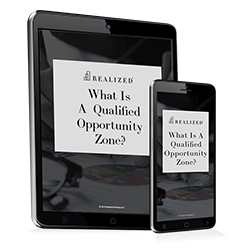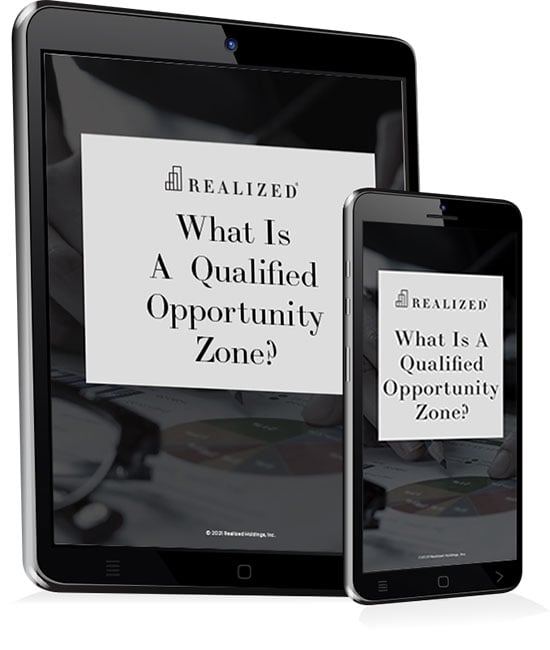Realized recently joined the Opportunity Zones podcast for a panel on Opportunity Zone (OZ) investment strategies. The panel discussed a variety of ways that investors can seek to maximize the tax efficiency of their investments. They also compared Opportunity Zones and Delaware Statutory Trusts (DSTs) in terms of benefits and challenges for investors. Here are some of the key takeaways from this panel.
What Are DSTs?
Delaware Statutory Trusts, or DSTs, are legal entities that can be used to hold multiple revenue-generating properties. DSTs are a way to build a diverse portfolio of investment properties without having to manage those properties yourself. At Realized, we help our clients invest in DSTs using 1031 Exchanges. A 1031 Exchange allows you to sell an investment property and then reinvest the return into a replacement property while deferring capital gains taxes.
What Are OZs?
Opportunity Zones, or OZs, are low-income areas that have been designated for economic development by the US government. You can invest in developments in these areas by contributing to Qualified Opportunity Funds (QOFs) or investing in new developments directly. Individuals who invest in OZs will qualify for certain tax benefits. OZs are usually ground-up developments and can take years to see returns. Although they can be considered high risk, they can also generate high returns in the long run. Although Realized focuses primarily on DSTs and 1031 Exchanges, we can also help our clients add Opportunity Zones to their portfolio if it aligns with their investment goals.
What Are the Differences between OZs and DSTs for Investors?
Opportunity Zones and DSTs both offer ways to reinvest your money after selling a property. You can use a 1031 Exchange to reinvest in DSTs, or look for Qualified Opportunity Zone projects (QOZs) to reinvest in. Both of these strategies provide opportunities for deferral on capital gains taxes. There are some key differences between the two, and it’s important to keep these in mind when deciding where to reinvest your money.
The first key difference is what you can reinvest. With a QOZ, you can invest any capital gains, and they don’t need to come from real estate. In this situation, you would only reinvest the capital gains, rather than reinvesting the basis. If you choose to invest in a replacement asset later on, you can reinvest 90 percent of that asset. It must be a like-kind real property as defined by the IRS.
With a 1031 Exchange, you can only reinvest real investment property, so you’re limited on what you can reinvest. You’ll also need to reinvest both the basis and the capital gains from your sale to receive the tax benefits.
Another key consideration is when you can invest in these properties. In general, 1031 Exchanges have much tighter reinvestment timelines. You’ll have 45 days after the sale of your property to identify a replacement. You will then need to reinvest that money within 180 days. You cannot change the property you want to invest in once you have identified it. Investment timelines for QOZs are slightly more lenient. In order to receive tax benefits, you will need to invest within 180 days of your original sale. Gains must be triggered on or before 12/31/2026 in order to receive tax benefits.
With a QOZ, you’ll need to hold the asset for at least 10 years in order to reap the tax benefits. Minimum holding periods for 1031 Exchanges vary, but they are typically much shorter. With a 1031 Exchange, you can sell at any time once the minimum holding period has passed and you find a qualified buyer. With a 1031 Exchange, taxes are deferred once reinvestment is complete.
There are a few other key differences to keep in mind with these two investment strategies. QOZs are limited to certain locations in designated zones. With a 1031 Exchange, you can reinvest virtually anywhere in the United States. Additionally, 1031 Exchanges require a Qualified Intermediary (QI) to hold the money during the transaction. If you don’t find a QI, this could compromise your exchange. QOZs do not need a QI.
Which Is Better - QOZ or 1031 Exchange?
Both QOZ investments and 1031 Exchanges have their benefits - the right decision for you will depend on your financial situation. Both of these investments are complex, and you will need a qualified advisor to guide you through the reinvestment process. It’s important to note that Opportunity Zones are significantly more complex than 1031 Exchanges, and it may be difficult for investors to find advisors that are appropriately qualified.
Opportunity Zones are typically more effective for investors who are selling a property with a very high basis and have minimal debt. This is because you only need to reinvest the capital gains with an OZ, whereas a 1031 Exchange would require you to reinvest the basis as well. In a situation where you have a high basis, it is slightly more difficult to diversify. In reverse, a 1031 Exchange is usually better for investors who are selling a property with a lower basis and have higher debt on that basis. A 1031 Exchange makes it easier to defer taxes on this sale.



